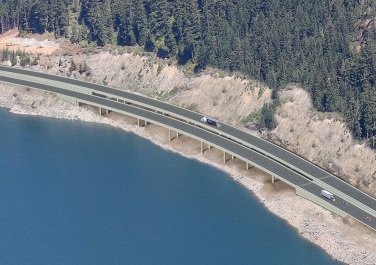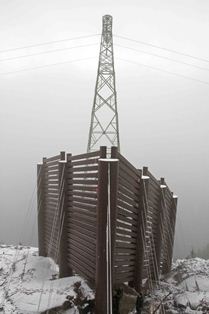| Home |
Who we are |
What we do |
Our projects |
Contact us |
Our ProjectsI-90 Snoqualmie Pass East Avalanche MitigationIn partnership with URS Corporation and the Washington State Department of Transportation (WSDOT), we provided avalanche design criteria for a six-lane clear span snowshed to replace the existing two-lane snowshed. Due to its length, the proposed snowshed would function similarly to a tunnel, requiring lighting, ventilation, fire protection and monitoring. Guy F. Atkinson, the general contractor, has designed an avalanche bridge to replace the snowshed. The bridge will cross over the avalanche paths with clearances up to 70 feet and allow snow to pass underneath. Bridge piers will be designed to withstand avalanche impacts. We provided technical review of the contractor's plans, including a quantitative risk assessement for the snowshed to allow comparison of risks between the snowshed and avalanche bridge options. |

We also provided design layout and specifications for avalanche starting zone structures (snow nets). These steel cable meshes are anchored into the ground to hold the snowpack in place and prevent initation of large avalanches that can reach I-90 travel lanes.
WSDOT will install real-time instrumentation to monitor stresses and deflections in the snow nets and corresponding snow heights and densities. This information will be used for day-to-day avalanche forecasting and control work, and to provide a better understanding of snow net performance for maintenance, repairs and future designs in this deep maritime snowpack. For more information, go to WSDOT Project Site
Snettisham Transmission Tower, Juneau, Alaska

The Snettisham 138kV transmission line connects Alaska's capital to a source of abundant clean hydroelectric power. This line traverses rugged terrain with significant avalanche exposure. We worked with Alaska Electric Light and Power, and Dryden & LaRue to provide recommendations and avalanche design parameters for protecting one of the most exposed transmission line towers.
A massive, reinforced concrete splitting wedge was considered but eliminated due to difficulties and expenses in transporting heavy materials to this remote location by helicopter. The solution became a porous steel structure consisting of tubular steel and steel sections designed to function similarly to a concrete wedge. The wedge is approximately 40 feet high. Unlike concrete, the steel wedge is designed to flex during impact, thereby reducing peak impact pressures. Construction was completed in October, 2009.
In March 2012, the structure survived its first full scale field test when an estimated 30-year return period avalanche impacted the splitting wedge. KTOO News Story ISSW 2012 Paper Two similar splitting wedges were constructed to protect nearby towers. AEL & P Press Release
Residential Avalanche Hazard Mapping and Mitigation
We have provided avalanche hazard mapping, and mitigation design parameters for residential developments and structures in:
- Pitkin, San Juan, Summit Counties, and Ophir, Colorado
- Ketchum, Sun Valley, and Blaine and Camas Counties, Idaho
- Taos Ski Valley, New Mexico
- Summit and Salt Lake counties, and Sundance, Utah
- Chelan County, Washington
